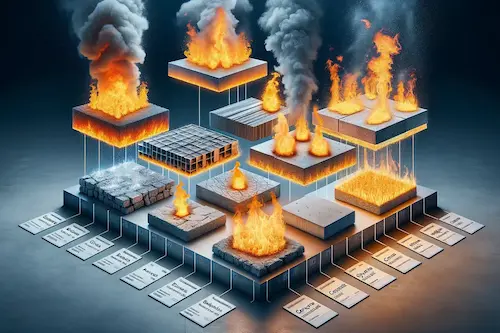Building for Resilience: Key Fire-Resistant Construction Techniques for a Safer Future

Wildfires are an increasing concern, particularly in fire-prone areas like California. The recent fires in Altadena and Pacific Palisades highlight the need for homeowners and builders to adopt fire-resistant construction techniques to protect properties and enhance safety.
By integrating fire-resistant materials, strategic design principles, and proper landscaping, homeowners can significantly reduce the risk of fire damage.
Here, we explore key construction techniques that improve fire resistance and contribute to safer, more resilient homes.
- Fire-Resistant Building Materials
The materials used in construction play a crucial role in enhancing fire resistance. Some of the most effective fire-resistant materials include:
- Concrete and Masonry: Concrete, stone, and brick are non-combustible and offer excellent fire resistance. These materials do not ignite and can withstand extreme heat, making them ideal for home exteriors.
- Fire-Rated Glass: Traditional windows can shatter under intense heat, allowing flames to enter a home. Fire-rated glass, such as tempered or multi-layered glass, provides better resistance to heat and impact.
- Steel and Metal Roofing: Roofing is a vulnerable area during wildfires. Using metal roofing or fire-resistant shingles (Class A-rated) significantly reduces the risk of embers igniting the home.
- Fiber Cement Siding: Unlike wood, fiber cement is non-combustible and offers the appearance of natural materials without the fire hazard.
- Fire-Retardant Treated Wood: If wood is necessary, choosing treated wood with fire-retardant chemicals helps slow ignition and flame spread.
- Smart Home Design for Fire Resistance
In addition to materials, home design can make a significant difference in fire protection. Here are some crucial design considerations:
- Defensible Space: Creating a defensible space around a home by clearing away flammable vegetation and debris reduces the likelihood of fire spreading.
- Multi-Pane Windows: Installing double or triple-pane windows enhances thermal resistance and reduces breakage from extreme heat.
- Enclosed Eaves and Vents: Open eaves and vents are entry points for embers. Installing ember-resistant vents and enclosing eaves minimizes fire penetration.
- Non-Combustible Decking: Wooden decks are highly flammable, but materials such as concrete, stone, or fire-resistant composite decking improve safety.
- Sloped Roofing with Minimal Overhangs: Sloped roofs help prevent embers from accumulating, and minimal overhangs reduce the risk of fire spreading to the structure.
- Fire-Resistant Landscaping Strategies
Landscaping plays an essential role in fire prevention. The right choices can create a buffer zone that prevents fire from reaching the home.
- Zone-Based Landscaping: Implementing defensible space zones with increasing distance from the home, such as:
- Zone 1 (0-5 feet from the home): Use gravel, stone, or concrete walkways and avoid plants that produce dry, dead materials.
- Zone 2 (5-30 feet from the home): Maintain well-irrigated, fire-resistant plants and prune tree branches.
- Zone 3 (30-100 feet from the home): Thin out larger vegetation, remove dead trees, and create firebreaks with hardscaping elements.
- Choosing Fire-Resistant Plants: Certain plants, such as succulents, agave, and lavender, retain moisture and are less likely to ignite.
- Proper Irrigation: Keeping plants and soil hydrated reduces fire susceptibility, making a strong irrigation system a critical component.
- Protective Exterior Features
Beyond home materials and design, additional protective features can make a home more resilient to fire.
- Fireproof Shutters: Installing non-combustible shutters protects windows from radiant heat and flying embers.
- Automatic Sprinkler Systems: Exterior sprinkler systems can wet the home and surrounding areas before a fire arrives.
- Metal Mesh Screens: Covering chimneys and vents with fine metal mesh prevents embers from entering the home.
- Fireproof Doors: Exterior doors should be constructed from solid wood, steel, or fire-rated composite materials for better protection.
- Fire-Resistant Home Technology
Modern technology offers innovative solutions for fire protection.
- Fire Detection Systems: Advanced smoke detectors and smart fire alarms provide early warnings.
- Smart Monitoring Systems: Remote monitoring of fire threats using weather and satellite data can help homeowners prepare in advance.
- Backup Power and Water Supply: Having backup power generators and an independent water source can provide crucial support during emergencies.
- Compliance with Fire Safety Standards
Building codes and regulations are evolving to address wildfire risks. Homeowners should ensure compliance with the latest fire safety standards, such as:
- California’s Wildland-Urban Interface (WUI) Code: Homes in fire-prone areas must adhere to specific fire-resistant construction guidelines.
- National Fire Protection Association (NFPA) Standards: NFPA provides best practices for fire safety in residential buildings.
- Local Building Codes: Working with local fire departments and building authorities ensures that homes meet current fire-resistant construction requirements.
- Retrofitting Existing Homes for Fire Resistance
For homeowners looking to enhance the fire resistance of their current properties, retrofitting offers an effective solution:
- Replacing Roofs with Fire-Resistant Materials: Upgrading to Class A fire-rated roofing improves safety.
- Sealing Gaps and Openings: Small gaps in siding, roofing, and vents can allow embers to enter. Sealing these openings reduces vulnerability.
- Upgrading Windows and Doors: Installing fire-rated glass and solid-core doors provides additional protection.
- Improving Home Exteriors: Adding a layer of fire-resistant stucco or masonry over existing siding can enhance fire resistance.
Building a fire-resistant home requires a combination of fire-resistant materials, smart design choices, effective landscaping, and modern protective technologies. The recent devastation in areas like Altadena and Pacific Palisades underscores the importance of proactive fire mitigation strategies. For those seeking new construction or home improvement services, resources like Pacific Palisades Home Builders offer expertise in fire-resistant design. By incorporating these techniques, we can create safer, more resilient communities for the future.